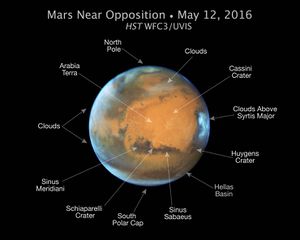Observing Mars with a Telescope
volunteer for The Mars Society
It is licensed under Creative Commons BY-SA 3.0 and may be freely shared, but must include this attribution.
Mars constitutes the only planet in the solar system with surface features easily distinguishable from Earth—of the inner planets, Mercury’s small size and proximity to the sun make viewing exceptionally difficult, while Venus’ surface hides behind a thick layer of clouds. [green] As such, Martian surface features have long captured the imagination of astronomers, even helping lead to the longstanding popular belief of its inhabitation by extraterrestrial civilization. In 1877, Italian astronomer Giovanni Schiaparelli began mapping areas on Mars, including long, dark lines he named “channels”, or “canali.”[]. Mistranslations of this word to English “canals” along with his own observations encouraged American Percival Lowell to theorize that these dark lines were the work of intelligent beings attempting to irrigate their dying planet [1]. Although these lines were later revealed to be an optical illusion resulting from the mind’s attempts to connect dark areas at the extent of its vision [2], even amateur astronomers can make out a variety of other surface features with the aid of a telescope.








